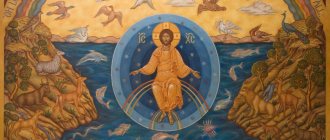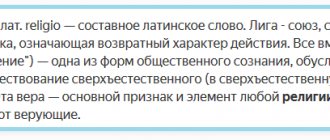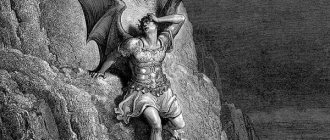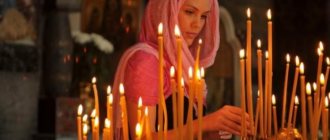Demon in Christianity and esotericism
In the Christian world, “demon” is a collective name for most dark entities: evil spirits, goblin, water spirits. All of them are on the other side of God and bring people only troubles and misfortunes. Once upon a time, according to the Bible, the angel Lucifer was cast into hell for disobedience and pride. Some of the angels took Lucifer's side in the struggle for power and were overthrown along with him. Now they serve the forces of evil, poisoning the souls of people.
In demonology (the science of demons), devils, devils, demons are at different hierarchical levels. They all have different powers and influences. Demons are in position between powerful demons and helpful devils who are only capable of minor mischief. They are cunning and cunning. Only a madman would decide to contact them of his own free will. Demons live among people, waiting for the right moment to confuse them and lead them astray from the righteous path.
It's all about me, how bad I am
Esotericists explain in their own way who a demon is. They claim that next to the familiar real world there is a subtle energy world. We don’t see or feel it, but various spiritual entities live in it. For some people are of no interest, others just watch us. But there are parasitic entities! These are the devils and demons. These are ordinary inhabitants of the lower astral plane, a kind of subtle matter that can negatively affect a person’s fate. Only people with certain abilities can see them. But many can feel the presence.
Evil spirits can give themselves away by an unpleasant odor, strange sounds or bodily touches. A person may experience an unexpected feeling of fear. Spirits feed on the energy of hatred, lust, envy, gradually depleting a person.
Mermen
A more typical evil spirit for reservoirs was the waterman, who was also called the waterman, the water master, the water devil, the water grandfather, the fireman, the hairy man and the water jester. The Belarusians called a water person living in a pool - omutnik, in a whirlpool - virnik, in stagnant water - quiet.
As with most evil spirits, there was not one single image of a merman for all of Russia, Ukraine and Belarus. The only thing in common is that a merman lives in a body of water and controls it.
The merman is a blue-faced old drowned man covered in algae. Vodyanoy is a naked, hunchbacked, fat man with a long gray beard. The merman is a monster with a sharp head, burbot skin, horn, goose legs and a fish tail. A merman is a devil with thick black fur, hooves and a cow's tail. Often he rode a huge catfish.
The merman was usually hostile to people. He lured them into rivers and drowned them, turning over their boats. At the same time, everything that fell into the water was considered to be in the power of the merman, which is why sometimes people were in no hurry to save the drowning, so as not to completely ruin their relationship with the merman. The fishermen and millers simply could not live without his support. And it was customary to bestow gifts on him.
In especially large reservoirs there lived several mermen, and above them there was a king. The merman was shown either as a bachelor, eager for mermaids, or as a family evil spirit, married to a merman.
Vodyanoy Ivan Bilibin
Why is a demon dangerous?
Demons are cunning, dangerous entities. They hate God and everything he created. That is why they constantly harm a person, denigrate the soul, and induce suicide. At the same time, they never forget about their benefits. Having concluded an agreement with a person, they lead him into temptation and force him to commit sinful atrocities.
A dark spirit can influence a person's decisions and actions. He defines his victim by evil and insidious thoughts. It is impossible to hide dark intentions from him. Whoever allows such a demon into himself will be doomed to commit a crime, joining the ranks of sinners in hell.
Everyone has a demon
Demons are considered the creators of all sinful activities:
- occultism;
- fortune telling;
- love spells;
- causing damage.
Having gained trust, they deceive people and profit from their troubles. By not believing in God, we deny the existence of an evil spirit, thereby exposing ourselves to danger. Priest Vitaly Sknar wrote in his article:
“Demons really exist and have now achieved great results, convincing people that they do not exist... If we believe that the devil is an allegory... we disarm ourselves before the forces of evil...”
Evil spirits skillfully disguise themselves, taking on the appearance of our loved ones and acquaintances. To achieve their goals, they can transform into an angel or even a son of God, or they can become invisible. They are not shown to humans in their real form - their horns, tail and hooves give them away.
The Bible and what came before it
Even before Christianity arose, one could become acquainted with demons by studying shamanism. It was already there that it was explained in detail who they were and how to expel them. Although in the Christian tradition, of course, this is not recognized and they claim that Christ was the first to engage in exorcism. After all, it was he who somehow healed a man enslaved by a demon, freeing his soul.
Dark entities forced the victim to live in a coffin. One phrase was enough for Jesus to command the dark spirits to fly away and fly into the pigs. According to Christians, God endowed individual apostles and other saints with a special gift of expelling evil spirits. Nowadays, there are many lovers of mysticism looking for it on the pages of books and movie screens. There are many films on this topic.
Demon Possession
Possession is not a rare phenomenon in Christianity. Having taken possession of a person, the demon torments the body and soul, changes the person’s consciousness, and kills the person. It is not entirely clear what goals the entity pursues. Christians believe that evil spirits are trying to use someone else’s body as a weapon against God’s creatures. Or perhaps the demon is trying to prove to non-believers that dark entities exist and must be taken into account. It usually inhabits the body of a weak-spirited person or a sinner.
Esotericists claim that possession is possible only when a person’s protective shell is violated. An energy hole in one of the subtle bodies makes it defenseless. All dangerous astral entities rush into it. They tear the soul away from the body, penetrate the consciousness, and instill in the victim the idea of suicide.
Whether a person is obsessed or not can be determined by the following signs:
- sudden change in behavior, aggression;
- non-acceptance of the church, shrines;
- swearing, spitting on the cross;
- seizures similar to epilepsy;
- hallucinations;
- change in voice or manner of communication;
- amoral behavior;
- thoughts about suicide.
Individuals who use alcohol or drugs are most susceptible to obsession. Their consciousness is easily receptive and suggestible. Demons also easily inhabit the bodies of criminals: murderers, thieves, maniacs. People who, in their opinion, commit minor sins are suitable for the role of a victim: liars, traitors, envious people who do not consider themselves sinners at all. There is no God in the souls of such people, so evil spirits do not meet any resistance.
About the term
In the 11th century, one can hear for the first time that there is a special image in Christianity - a demon. Who is this? One could learn about this by reading the lines of “The Tale of Law and Grace” or in the epic telling about the campaign of Prince Igor and his regiment, written in the 12th century. In addition, who the demon is in Christianity can be found out from many other works.
In fact, this was the name given to all images that had anything to do with paganism. The great Veles did not escape this nickname either. A demon (Christianity) is any entity whose existence contradicts the supremacy of God in the spiritual world. If you look at a 19th century Bible translation, you will also notice this term. In English, as well as in German, this word is perceived as a synonym for the word “devil”. The Slavs borrowed it from the inhabitants of the Indo-European territories, for whom it meant “fear.” The Greeks called the monkey that way.
According to the pagan Slavs, winter is the time of the reign of demons who send cold. They are also associated with the dark time of day. In a word, these creatures were credited with involvement in all natural phenomena that disturbed human peace and comfort.
The rescue
But there are still ways to fight evil spirits. The main weapons against demons are true faith in God, attending church, and observing God’s commandments. The Gospel says: “Every kind of demon is cast out by prayer and fasting.” God and faith in him are the only things that dark forces cannot resist. The most effective prayers for protection are:
- "Our Father";
- prayer to the Guardian Angel;
- Psalm 90.
The church is a closed territory for dark forces. If evil spirits have settled in a home, a church minister can drive it out. He will consecrate all the corners of the house and say prayers. You can perform this ritual yourself by sprinkling the rooms with holy water and reading the “Our Father.”
A pectoral cross helps against any evil spirits. Incense and icons are an excellent means of protecting your home; they are placed as a talisman in every room. Repels evil spirits and wormwood smoke.
Ritual of expulsion
Anyone who cannot cope with such an entity as a demon on their own turns into a possessed person. In these cases, the rite of exorcism is applicable. Only experienced priests are engaged in expelling evil spirits. In the name of Christ they force evil spirits to leave the body. The ritual is very dangerous, since during it not only the possessed person, but also the clergyman can die. Therefore, the church rarely gives consent to the ritual.
Do you think you can drive me out?
During the session, evil spirits scream in different voices, shouting curses and threats. At this moment, you can find out from the spirit its plans, find out what exactly it wants. A church minister forces the entity to leave someone else's body with prayers. Only a true believer can achieve results.
The author of the book “People and Demons,” priest Rodion, wrote:
“The ability to perform exorcism is a gift from God. This is a difficult and thankless gift here on earth... in addition to fasting and prayer, great humility, strong faith and devotion to the will of God are necessary.”
Prohibition of witchcraft with the help of demons and sacrifices to them [↑]
In ancient times, magic with the help of demons was widespread - when shedim, forced by special spells, performed any actions ( Sanhedrin, l.67B, com. Rashi
).
The Jews encountered this during the time of Egyptian slavery and, following the Egyptians, began not only to cast magic in this way, but also to worship demons and make sacrifices to them. After leaving Egypt, the Jews received two commandments - the prohibition of witchcraft and the prohibition of idolatry, including the worship of shedim ( see Shemot, 20:3-4, Vayikra, 17:7, Devarim, 32:17 and Ramban
).
Demonic hierarchy
Holy Scripture gives a complete answer to the question: “Who is a demon?”, but does not explain what position he occupies in his world. Church ministers suggested that Hell is a reflection of Heaven, and by analogy with it, they divided dark entities into 9 ranks.
Each of the ranks is busy with their own business: one evil spirit impersonates God and expects obedience, the other forces people to lie and break laws. Someone incites conflicts and causes illness, and someone fools the minds of non-believers with pseudo-miracles. All of them are subordinate to Lucifer.
Imp Essence
All entities are divided into three levels:
- On the first level there are former cherubim and seraphim. For example, the cherub Balberit incites conflicts in the family, and Asmodeus inspires a person that money and luxury are the highest goal of life.
- The second level is the ranks of power and dominion in the angelic hierarchy. The demon Elle makes a person insatiable for wealth, and Rosier inclines the weak in spirit to debauchery and gluttony.
- The third level was occupied by former archangels, angels, and principles. Belial, the demon of arrogance, has great influence over women and children, and the archangel Olivia inspires hatred of the poor and forces them to treat people with cruelty.
Temptation of Saint Anthony
Demons act only where the Lord allows them to do so, turning the evil plans of fallen spirits for the good of people. This partly explains Goethe’s famous paradox of Mephistophelian self-determination: “I am part of that force that always wants evil and always does good.” Although even in a literary work, the demon still continues to lie: he, of course, is not able to accomplish any good and, as always, ascribes to himself the merits of others.
Hieronymus Bosch. Temptation of Saint Anthony But what can a demon really do? In this matter, the opinion of the father of Christian monasticism, Anthony the Great, can be considered more than authoritative, since demons fought with him in the desert for several decades. Hieronymus Bosch’s famous painting “The Temptation of Saint Anthony” depicts a terrible picture: a flock of fanged and horned monsters attacks a lone monk. This plot was not invented by the artist, it was taken from the real life of St. Anthony, and the saint actually experienced all these terrible attacks. But this is the unexpected assessment that Anthony the Great himself gives to these horrors: “In order not to be afraid of demons, we must consider the following. If they had power, they would not come in a crowd, would not make dreams, would not take on various images when plotting; but it would be enough just to come alone and do what he can and wants, especially since everyone who has power does not amaze with ghosts, but immediately uses the power as he wants. The demons, having no power, seem to amuse themselves at the spectacle, changing their disguises and frightening children with many ghosts and phantoms. That’s why we should despise them most of all, as the powerless.”
Do demons have names?
Every demon has a name. Knowing it, you can summon a dark entity. The most common among us are:
- Prodigal or demon of fornication. Pushes a person to carnal pleasures, inclines him to treason, makes him conduct lustful conversations and seduce the innocent. It is Prodigal who causes crimes of a sexual nature: perversion, rape, child molestation. Only deeply religious people can resist him.
- Midday or Midday Demon. It will easily take the souls of people who are in constant despondency, those who are always dissatisfied with life, who hourly complain about fate and about God. In Christianity, such people are called weak in spirit. They are usually lazy and indifferent to everything that happens. If a person constantly feels a decline in spiritual strength and is not interested in anything, this is a clear sign that Midday has attached itself to the energy shell and is sucking out strength.
- Luck. When you meet him, you will be sure that luck is in your hands. The demon will present a real gift that is difficult to refuse - a big cash win, luck in love affairs or business. But you have to pay for everything! The price is the human soul. There are many people who agree to go to Hell after death. After all, they believe little in hell, but they want to get a comfortable life full of pleasure now. By wishing “good luck” to your loved one, you risk bringing disaster upon him. Don't throw out such wishes. Demon Luck is always on the alert!
Each of us contains particles of light and dark. We are subject to anger and despondency, we can be deceitful and become proud. At the same time, we do not consider minor offenses to be sins. In the age of fast technology, we work a lot and sleep little. We are always in a hurry. We don't have enough time for simple communication and caring for loved ones. It is impossible to force everyone to attend church and read prayers before bed. But knowing who the demon is, we must be careful about our words and actions, not offend loved ones, observe the laws of life and simple rules of decency.
Who drowned the pigs?
People who are becoming acquainted with the Gospel for the first time sometimes pay close attention to those details of the Gospel narrative that for a churchgoer are secondary and insignificant. One such case is described by N. S. Leskov in the story “At the End of the World,” where an Orthodox bishop, traveling through Siberia, tries to explain to his Yakut guide the essence of the Christian faith: “Well, do you know why Christ came here to earth? He thought and thought - and did not answer. - Do not you know? - I say. - Don't know. I explained all of Orthodoxy to him, but he either listens or doesn’t, and he keeps giggling at the dogs and waving the weeds. “Well, do you understand,” I ask, “what I told you?” - Why, bachka, I understood: he drowned a pig in the sea, he spat in the eyes of a blind man - the blind man saw, he gave a loaf of bread to the people. These pigs in the sea, a blind man and a fish, stuck in his forehead, and he won’t rise further...” Paradoxically, all the same pigs that stuck in the forehead of Leskov’s illiterate Yakut, today can sometimes confuse already quite civilized people with higher education . How could the meek and loving Christ, who “will not break a bruised reed or quench the smoking flax,” mercilessly drown a herd of pigs? Doesn't God's love extend to animals too? The questions seem to be formally correct (although they could probably only arise from a modern person who in no way connects the ham on his table with the pig from which this ham was made). But there is still an error in such reasoning. And the point is not even that the pigs mentioned in the Gospel would sooner or later still fall under the butcher’s knife.
Temptation in the desert










